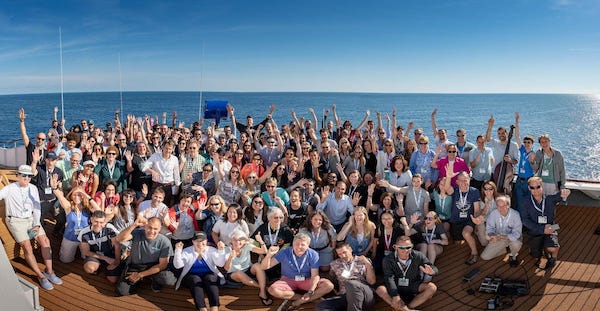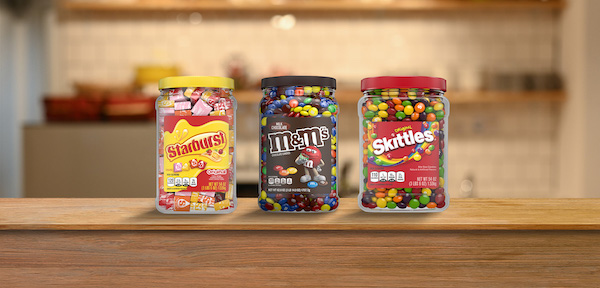This article is sponsored by Berry Global.
The summer of 2019 changed my life for the better. I was one of more than 150 NGO and corporate leaders who climbed aboard an expedition ship to participate in the Ocean Plastics Leadership Summit, hosted by the Ocean Plastics Leadership Network, connecting 400-plus activist-to-industry organizations worldwide on behalf of the ocean plastics crisis. Off the subtropical island of Bermuda, we snorkeled through the heartbreaking “plastic-studded wastes” of the North Atlantic Gyre, one of the five major ocean plastics hotspots. If they didn’t before, every person on that boat walked away from the educational, emotional and humbling experience with a greater understanding of and appreciation for the global plastic waste crisis.

![]()
![]()
As a leading plastics packaging business with around 46,000 employees across more than 265 locations around the world, we at Berry recognize the global problem and the role we play in eliminating it. Consumers and investors alike are rightfully demanding change and looking to brands they trust to help end plastic waste. Leveraging our unmatched global capabilities, sustainability leadership and deep innovation expertise, those brands look to us to help them keep natural resources in use and out of our environment.
Walking the talk
Truly accelerating a circular economy requires a multipronged, Swiss Army knife approach with collaboration up, down and all around the global value chain, including investments in education and infrastructure to support the transition away from the outmoded “take-make-waste” approach.
While these have been challenging times, we at Berry know the future is centered around circularity. While we manage the short term in a very strategic, balanced manner, we are taking the long-term view by prioritizing innovations for circularity as a key growth driver. Doing so builds an attractive portfolio for our customers while driving growth, jobs and stability.
Motivated and encouraged by our customers’ ambitious sustainable packaging goals, we are dedicated to designing and developing products and materials that advance a pathway to circularity by increasing the use of recycled and renewable materials, minimizing waste and improving recyclability. Because it is lightweight, high performing, lower-carbon and cheaper than many other substrates, plastic has a critical role in advancing the circular economy. Instead of using virgin plastic from fossil fuels, though, we need innovative, circular products that are made to be remade.
Closing the loop
By securing agreements across advanced and mechanical recycling streams, our company will have access to over 600 million pounds of recycled content per year starting in 2025. And we will soon be opening an industry-leading recycling facility in Leamington Spa, United Kingdom. Using Berry’s proprietary closed-loop CleanStream recycling technology, our new facility will not only recycle domestically recovered household waste polypropylene (PP) but it will also wash, sort and sift these used plastics to produce food-grade materials with a remarkable target purity standard of 99.9 percent. According to a life cycle analysis, packaging made with recycled material from our Leamington Spa facility will generate 35 percent lower CO2 emissions than virgin plastic production.
That will advance a lower-carbon, “cradle to cradle,” rather than “cradle to grave,” approach by mechanically processing domestically recovered household plastic waste back into packaging, including cosmetics, personal care and food applications. Berry is leading the charge in offering a true value proposition around recycling and packaging, showing how companies can do well by doing good.
From proof of concept to proof of value
Because Berry’s global footprint and leading purchasing scale offers unique access to the supply of high-quality recycled material, we are continuously testing new sustainable packaging solutions to take proof of concepts to scale. For example:
- We are working with Wendy’s to move from a selection of plastic-lined paper cups to easily recyclable plastic cups that use 20 percent recycled plastic based on mass balance. In the first two years alone, it is estimated this shift will divert around 10 million pounds of waste from landfills.
- We partnered with Mars Wrigley to launch a new line of treat jars that are not only lighter weight compared to previous versions, but also include 15 percent post-consumer resin — eliminating around 300 tons of virgin plastic per year.
<figure data-align="center" data-caption="New M&M’S, SKITTLES and STARBURST jars, which come in three sizes, 60-, 81-, 87-ounces, made with 15 percent recycled plastic. Image courtesy of Berry Global.“>
![]()
![]()
- Taco Bell is testing our new plastic cup and lid set using 10 percent recycled, high-density polyethylene (HDPE) that contains food-grade content from products such as recycled milk jugs.
- Bolstered by the EU Single-Use Plastics Directive, carbonated soft drink bottlers will soon have access to our award-winning tethered closure designed to remain intact with the bottle — making it less likely to be littered and more likely to be recycled.

![]()
![]()
As promising as these advancements are, without widespread changes and investments in infrastructure, it will be nearly impossible to provide enough recycled content to deliver on ambitious, sustainable packaging goals. It’s the biggest barrier and the solution can’t be addressed by one sector alone.
The wide variety of recycling collection and inconsistent education make for a grossly inefficient recycling system, one that must be harmonized. Likewise, the plastics industry must collaborate across the value chain to invest in education and infrastructure designed to increase access to recycling and improve the collection and recyclability of plastic waste.
Collaboration is key
From agreements for circular resins and enhanced recycling infrastructure to joining with industry allies for change, collaboration is critical to truly advancing a circular economy. For instance, we are working with food brand Heinz, retailer Tesco, advanced recycling leader Plastic Energy and Saudi-based chemicals giant SABIC on an innovative recycling trial in the U.K. designed to close the loop on soft plastic food packaging. Flexible plastic packaging collected and converted by Plastic Energy from Tesco stores is used to produce certified circular polypropylene from SABIC’s TruCircle portfolio for microwavable Heinz Beanz Snap Pots, made from 39 percent recycled soft plastic. Berry manufactures the new packaging and sends it to Heinz for filling with Beanz and delivery to Tesco. Once emptied, the pots and sleeves can be returned to curbside collection points.
<figure data-align="center" data-caption="Heinz and Tesco partner with Plastic Energy, SABIC and Berry Global to launch sustainable packaging innovation made with post-consumer recycled soft plastics. Image courtesy of The Kraft Heinz Company / Wonderland Comms.“>
![]()
![]()
In addition to setting a goal to use 30 percent circular plastics in our fast-moving consumer goods packaging by 2030, as well as science-based emissions reduction targets and minimizing our waste, water and energy use, we partner with leading NGOs critical to the success of ending plastic waste. We’ve signed on to the Ellen MacArthur Foundation’s New Plastics Economy Global Commitment to change how plastic is produced, used and reused, and we joined the World Wildlife Fund’s Bioplastic Feedstock Alliance to support the responsible development of plastics made from plant material. We have also taken a leadership role with the Alliance to End Plastic Waste and The Recycling Partnership to support education and infrastructure investments needed to increase the use of recycled content and improve the collection and recyclability of plastic waste.
Finally, launched at PACK EXPO International this fall, our new More Together initiative encourages employees, customers and partners to share their personal passions for creating change using the hashtag #Bmoretogether. This is more than a marketing campaign — it’s what our industry needs now to make progress toward a circular, net-zero economy. It’s a movement to activate personal sustainability motivations and listen for the next opportunity to act.
[embedded content]
As long as players up and down the value chain continue treating plastic waste with the urgency it deserves, I will remain hopeful. The effort requires the buy-in and coordination of the plastics industry, retailers and brand owners, consumers, recyclers, waste management organizations and governments at the local, national and international levels to build and maintain a viable infrastructure and business model that helps us all reach our collective environmental imperatives. It might sound like a monumental burden, but I know the plastics industry is up to the task — because the price of inaction is one that the whole planet will pay.
- SEO Powered Content & PR Distribution. Get Amplified Today.
- Platoblockchain. Web3 Metaverse Intelligence. Knowledge Amplified. Access Here.
- Source: https://www.greenbiz.com/article/how-global-plastics-leader-betting-big-circularity



